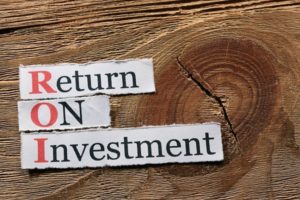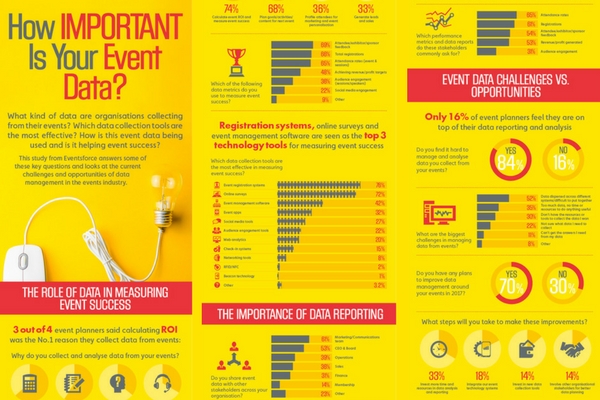 Last month, an EventTech Talk poll revealed that 50% of event planners do NOT measure the ROI of their events. Surprising and controversial, the result kicked off quite a bit of debate across online community groups with many event professionals voicing their opinions on what is ROI, what should be measured and how it should be quantified. And while there was common consensus on why ROI matters, there was also an underlying agreement that many of us don’t measure it as often as we should.
Last month, an EventTech Talk poll revealed that 50% of event planners do NOT measure the ROI of their events. Surprising and controversial, the result kicked off quite a bit of debate across online community groups with many event professionals voicing their opinions on what is ROI, what should be measured and how it should be quantified. And while there was common consensus on why ROI matters, there was also an underlying agreement that many of us don’t measure it as often as we should.
At a time when budgets are pinched even tighter and downsizing has become commonplace, seeing a quantifiable return on events has never been more important. And technology plays a key role here. It allows you to collect important data around your events (registration forms, surveys, RFID) and create all sorts of reports that help measure ROI. The problem is that the amount of data generated around an event can be overwhelming: from website traffic and social media engagement to registration and attendance. From the quality of your delegates to their feedback and evaluation. From the revenue generated to conversion rates and sales leads. Figuring out what your event system should measure and how best to measure it not as simple as one would have hoped.
Enter the world of onboarding.
A concept originating in the US, onboarding is traditionally associated with the process of familiarising and welcoming new employees into an organisation. It involves providing them with the tools, resources and knowledge to become more successful in their new work environment. Numerous studies have shown that when support levels are high, new hires often have more positive attitudes about their jobs and work harder. When support and direction aren’t offered, it has the opposite effect: unhappy and unproductive employees who don’t make it much further than four months1.
The same concept applies when you invest in a new event management system. What you get out of it (and ultimately, your event ROI) really depends on the kind of onboarding experience you have beforehand. Onboarding in this sense means ensuring you get the right kind of guidance, skills, consultation and training that can help you get the most out of your technology. A structured process that makes sure the system is going to collect and measure the right kind of information that allows you to meet the objectives of your event. Because without it – as with onboarding new recruits – your new technology may not deliver on its promises the way you had hoped.
Whether you’ve investing in a new event management system, an event app or any other kind of technology that allows you to capture data around your events, then onboarding is something you need to think about.
So How Does Onboarding Improve Your ROI?
 Before we go into what a good onboarding process looks like, we need to highlight the importance of who it is that delivers this service. In most cases, once you decide on a new system, your event tech provider will offer you a training session on the new system. You learn everything there is to know about each switch, button and feature. You go back and digest this information and configure it in a way that’s right for your specific event. This all sounds good but what happens when you have a sophisticated solution with a lot of functionality?
Before we go into what a good onboarding process looks like, we need to highlight the importance of who it is that delivers this service. In most cases, once you decide on a new system, your event tech provider will offer you a training session on the new system. You learn everything there is to know about each switch, button and feature. You go back and digest this information and configure it in a way that’s right for your specific event. This all sounds good but what happens when you have a sophisticated solution with a lot of functionality?
You don’t want technology to create more work for you – you want it to simplify processes. You want it to save you time and do more with your event data. Ultimately, you want it to increase the ROI of your events. Let’s take an example. Say you want to introduce paid-for events and need to integrate a payment gateway into your registration system. There are a number of things to consider here. What payment gateway should you choose? What discount rates should you apply? How will you monitor the status of payments? How will you measure the revenue you’re generating? Do you need this figure to be broken down by attendee type? Will you need to compare this from one event to the other?
A good onboarding team will assess these requirements and recommend the best way of configuring your system. It will recommend on the best processes and work flows you need to put in place. It will provide you with guidance on what data needs to be captured by the system in order for you to create the ROI reports that matter. Having this support from the start can help you avoid making any changes later on, which inevitably will cost you time and money.
The ABCs of Good Onboarding
Industry experience is critical to a good onboarding service. To ensure you get the most out of your investment, it helps getting advice from people who are experts in the field and have had plenty of experience in managing different types of events. They understand how events are run and the kind of challenges you face because they were once event planners too. They can give you the right kind of advice on how best to use the system, provide insight on potential problem areas and help you and your team identify how best to measure your event ROI.
1) Determining Your Event Goals
 The first part of the onboarding journey is to understand the business objectives of your events and identify key problem areas in your processes. To do this affectively, onboarding will involve top level decision makers across your organisation (from events and marketing to the communications, IT and finance departments) to set clear business goals and determine exactly what the organisation requires from the new system. Do you want to increase attendance with new or returning delegates? Do you want to increase revenue by introducing paid-for events? Do you want to cut the time spent on chasing payments? Do you want to create new leads in your sales database?
The first part of the onboarding journey is to understand the business objectives of your events and identify key problem areas in your processes. To do this affectively, onboarding will involve top level decision makers across your organisation (from events and marketing to the communications, IT and finance departments) to set clear business goals and determine exactly what the organisation requires from the new system. Do you want to increase attendance with new or returning delegates? Do you want to increase revenue by introducing paid-for events? Do you want to cut the time spent on chasing payments? Do you want to create new leads in your sales database?
The more stakeholders you get involved, the more likely the onboarding team can help you determine exactly what you want to achieve earlier on. If your CRM manager, for example, decides it could be a good idea for you to integrate your delegate data with your organisation’s CRM system, then you’re better off determining this at this stage. Why? Because making these software changes further down the process can be the source of a lot of frustration and cause delays.
2) Setting Up ROI Metrics
Once they have determined the end goals you and your organisation want to achieve from your events, the next step is figuring out what data needs to be captured, how it should be processed and what kind reports you need to produce. Will you be sending delegate lists to hotels and caterers? How often will you need to send those reports in the run up to your event? What kind of reports do you need about your speakers, sponsors or exhibitors?
Identifying the right reports is essential in measuring your event ROI. Is it numbers through the door? Is it session attendance or engagement? Is it money coming in? Is it the number of new registrations or how much time delegates are spending at the event? How you measure success will determine the kind of data you need to capture and the reports you need to produce. Onboarding can help you identify what you need to measure and ensure markers are placed across the system in all the right places.
3) Mapping Out Your Processes
 The next stage of onboarding involves collating all this information and putting together a process flow document, which often can be in the form of a flow diagram. The document needs to identify what data needs to be captured at each stage of your event lifecycle and how this can vary from one event to another – or even from one type of attendee to another. For example, with sponsors, you may have to collect information on fees and deadlines. With exhibitors, you may need to capture data on stand sizes. With delegates, it may be about capturing what sessions they want to attend or what kind of accommodation requirements they have. Future proofing is also key here. Onboarding will ensure that the process flow reflects how the system will be used in the future. For example, they can recommend configuring your system in such a way that when returning delegates are registering for your next event, their details are automatically prefilled within their registration forms. This time-saving approach to customer service is critical for some types of events.
The next stage of onboarding involves collating all this information and putting together a process flow document, which often can be in the form of a flow diagram. The document needs to identify what data needs to be captured at each stage of your event lifecycle and how this can vary from one event to another – or even from one type of attendee to another. For example, with sponsors, you may have to collect information on fees and deadlines. With exhibitors, you may need to capture data on stand sizes. With delegates, it may be about capturing what sessions they want to attend or what kind of accommodation requirements they have. Future proofing is also key here. Onboarding will ensure that the process flow reflects how the system will be used in the future. For example, they can recommend configuring your system in such a way that when returning delegates are registering for your next event, their details are automatically prefilled within their registration forms. This time-saving approach to customer service is critical for some types of events.
4) Advice on Best Practices
Working so closely with different types of organisations and their events allows onboarding to provide unique insight on some of the latest trends and compliance regulations in the industry. For example, you may need to store delegate card details to secure deposits for things like transport, hotel rooms, dinners etc. Onboarding can give advice on which payment gateways are best suited for this without making your organisation subject to PCI-DSS regulations. They can also advise on best practices around Data Protection regulations. Are you sharing detailed delegate lists with hotels and caterers or are you sharing only what is necessary? Are you using all the information you are collecting in your registration forms? If not, then how are you storing this data? Do you know the difference between ‘sensitive’ and ‘non-sensitive’ personal information and what kind of extra security precautions you need to be taking when storing this kind of data?
They can also advise on new trends that will have an impact on the way you run your events. One example is awards ceremonies. There is a lot more pressure on ROI, accountability and transparency and companies who have put themselves up for awards are starting to challenge judges and award organisations as to why they didn’t win (or get shortlisted). They want to justify their spend and find out how they can do better next time. As a result, more and more organisations are starting to store all submission data permanently so that they can answer queries, even months after the event.
5) Training & On-going Support
The process mapping document ensures that the solution will be set up and configured in a way that accurately reflects and measures the set objectives around the events. It also provides the basis (and agenda) for the product training that the onboarding team will conduct for all your end users. The training session will not only focus on features and functionality, but will also teach your team how to use the system based on the process flows that were specifically mapped out for you. It makes the whole process of IT training more transparent, straightforward and tangible. It also ensures that everyone understands all the set ROI objectives and what their work needs to focus on.
Written by Paul Harris and Ben Bradley, Eventsforce





















